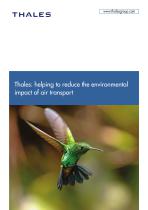
Catalog excerpts

Thales: helping to reduce the environmental impact of air transport
Open the catalog to page 1
With air traffic volumes expected to double over the next 20 years, the aerospace sector has undertaken to achieve a number of key objectives in the same timeframe: Reduce Decrease Generate less Cut noise hydrocarbons emissions A number of major international programmes are now working towards these objectives and developing concrete solutions. Thales's aerospace businesses are working to achieve these goals in three main ways: creating products that take the environment into account from the earliest design stage and throughout the product life cycle designing flight controls...
Open the catalog to page 2
Eco-design involves incorporating environmental considerations into product design and development to decrease the overall environmental impact of a product. It is a comprehensive approach to environmental performance based on multiple criteria and affects every stage in the product life cycle. J Choosing the best raw materials The overarching objective here is to reduce the overall weight of the equipment installed in the flight deck, cabin and cargo hold. Weight is clearly a critical factor in the aircraft industry: the heavier the aircraft, the higher the fuel consumption. Thales experts...
Open the catalog to page 3
energy management rained e ECO-PRODUCTS FOR AVIONICS Although the aerospace sector is not a leading cause of environmental concerns — air transport accounts for 2% of global CO2 emissions but meets 12% of overall transport needs — the industry has taken a number of major steps in recent years to reduce its environmental footprint. New aircraft engine designs have made a significant contribution to this effort. In addition, new navigational aids have played an active role in reducing CO2 and NOx emissions and curbing noise pollution: © optimised flight paths and ground movements © better...
Open the catalog to page 4
From pre-flight planning to pulling up to the arrival gate, Thales proposes innovative solutions for every phase of a flight. In addition to equipment and systems, Thales solutions include new tools for flight crews and new flight procedures that help to reduce pilot workload and further improve flight safety as well as cutting fuel consumption and noise pollution. jPre-flight planning: from pilot cases to tablets Many pilots still rely on paper documents for the crucial pre-flight preparation phase. But today they can access all the documents they need from an electronic flight bag. With...
Open the catalog to page 5
J Optimal take-off and climb Trajectory and engine thrust settings have a significant impact on fuel consumption and noise. As part of the European CleanSky programme, Thales has developed a new way for aircraft to take off. This procedure automatically adjusts speed, altitude and thrust to reduce noise levels for local residents as well as helping airlines to save on fuel costs. J I-4D: the fourth dimension Air traffic controllers currently manage flight paths in the three dimensions of altitude, longitude and latitude. Under the European SESAR programme, Thales is helping to build the...
Open the catalog to page 6
Continuous descent arrival can economise 100-200 kg of the 2,000 kg fuel carried by an A320 on a short 45-minute flight. Landing at any airport Not every aircraft can land at any airport unless the right equipment is available on board or on the ground. Thales is developing a new type of approach known as Localiser Performance with Vertical Guidance (LPV) and based on the EGNOS satellite navigation systems for Europe. Aircraft equipped with LPV can land at any airport, even when ILS systems are not available, limiting the need to install additional equipment on the ground. Another major...
Open the catalog to page 7
Global air traffic is expected to grow to between 415 and 500 million passengers per year by 2030 —double the figure of 228 million passengers recorded in 2005. Largely driven by emerging countries, this growth will expand the size of the global fleet of commercial airliners, which could increase from 1 5,000 aircraft today to 31,500 by 2030. Faced with these challenges, the air transport industry is working hard to raise levels of safety and efficiency, and to improve the sector's environmental performance at the same time. Thales is a market leader in avionics and air traffic management...
Open the catalog to page 8All THALES catalogs and technical brochures
-
RSM NG
2 Pages
-
STAR NG
2 Pages
-
DME 415/435 RPM
2 Pages
-
ILS 420
2 Pages
-
TopSky - AMHS
2 Pages
-
TopSky - AIM
2 Pages
-
TopDeck®
4 Pages
-
Avionics 2020
4 Pages
-
Helicopter Avionics
1 Pages
-
Scorpion
2 Pages
-
TopEagle
2 Pages
-
ILS420
2 Pages
-
DME415
2 Pages
-
CVOR431
2 Pages
-
DVOR432
2 Pages
-
NDB 436
2 Pages


















